The fight, which was not
As is known, the T-72 tank received its baptism of fire in 1982 in Lebanon. For a better understanding of the events described it makes sense to briefly focus on their background. So, 13 on April 1975, a civil war broke out in the Lebanese Republic that lasted 15 years. By summer, the country's government completely loses control over what is happening, the army is falling apart, and Palestinian militants are seizing the south - after the expulsion from Jordan, the main forces of the Palestine Liberation Organization were based in Lebanon. In April, Syria introduces 1976 thousands of soldiers to Lebanon in 5, and six months later, 30 thousands more as part of the so-called Inter-Arab Peacekeeping Forces, designed to stop the civil war. In essence, these “forces” became a cover for the Syrian occupation of 2 / 3 on the territory of Lebanon, which lasted until the 2005 year. From the very beginning of its existence, the “Inter-Arab forces” on 85 percent consisted of Syrians, and soon there were no one left except the Syrians. In March, 1978, in response to Palestinian actions, the Israel Defense Forces conducts Operation Litani and occupies southern Lebanon to the Litani River (except for the city of Tire). In June, Israeli troops left Lebanon, transferring control over the border strip of the Christian militia, led by Major S. Haddad. UN troops were brought into southern Lebanon.
In July 1981, the situation again sharply deteriorated - 10 days continued large-scale Palestinian shelling of the Jewish state from Lebanese territory. The Israel Defense Forces fired back and launched air strikes against Palestinian positions. With the American mediation, an armistice was concluded, which was observed in Lebanon with almost no violations until June 1982. However, Palestinian militants stepped up their operations in Israel and in Europe.
4 June 1982, the Israeli air force attacked nine targets of Palestinian forces in Lebanon. The Palestinians opened fire on the north of Israel (Galilee), whose air force responded with new raids. In the evening of June 5, Tel Aviv decided to launch Operation World of Galilee the next day. 6 June 1982, the 11.00 ground forces of the Israel Defense Forces entered Lebanon.
Merkava tanks enter Lebanon
Who is the winner? OPINIONS DISCOVERED
Actually, there is no need to explore the whole course of this war. We are interested in the fact that the Syrians and the Merkava Mk72 Israelis used T-1 in the process of its tanks. It is interesting because, firstly, these cars went into battle for the first time, and secondly, because you have to finally find out who is who. Regarding the latter circumstance, the most controversial opinions are found in foreign and domestic sources. For example, the famous American historian Stephen Pledge in his book “T-72 Main Battle Tank 1974-1993” reports the following: “For the first time T-72 was used in the battle in 1982 during Israel’s invasion of Lebanon. The Syrian army had approximately 250 machines T-72 and T-72M. The Syrian 82 Tank Brigade, equipped mainly with T-72 tanks, operated in Lebanon. According to the Syrians, a company of the 82 Brigade attacked a column of Israeli armored vehicles and was able to set fire to the 21 car, forcing the column to retreat. The company commander said later that the Syrian tankmen praised their T-72 armor for their ability to withstand the fire of 105-mm guns. Then the 82 Tank Brigade tried to break through to the rescue of the 1 Tank Division surrounded. However, she was ambushed by Israeli Merkava tanks and МХNUMX Nagmash tank destroyers armed with Tou missiles. The losses of the Syrians in this battle are not exactly known, but 113 tanks hit by the Merkami and 19 tanks hit by Tou missiles are reported. The Merkava tanks, armed with 11-mm cannons, could successfully hit T-105 with the help of the new M72 sub-caliber projectiles. The same can be said about Tou rockets. After the war, the Israelis declared that they had managed to capture eight T-111 tanks, of which two Syrians had abandoned without even turning off the engines. A few days later this information was officially refuted, although it seems true. ”
Domestic authors have a fundamentally different point of view, which is not surprising. In the article by V. Ilyin and M. Nikolsky “Lebanon-82. Has Israel conquered this war? ”Published in the magazine“ Technique and weapon"For 1997 a year, it was stated the following:" ... T-72 tanks showed their complete superiority over the enemy armored equipment. Affected by greater mobility, better security and high fire power of these machines. So, after the battle in the front sheets of some "seventy-twenty" counted up to 10 dents from the "blanks" of the enemy, however, the tanks remained operational and did not go out of battle. At the same time, the X-NUMX-mm shells of the T-125 confidently hit the enemy vehicles in the forehead at a distance of up to 72 meters. So, according to one of the eyewitnesses - a Soviet officer who was in combat formations of Syrian troops, after the shell of the D-1500TM cannon hit a distance of approximately 81 m in the tank "Merkava", the tower of the latter was disrupted from the epaulettes.
The subsequent course of events as presented by the authors is as follows: “The Israelis launched a“ psychic ”attack in an effort to master the most important strategic communication, the Beirut-Damascus Highway. However, this attack was repelled with heavy losses on the Israeli side. The Syrian T-72s from the 3 Tank Division were again distinguished. Its commander, Brigadier General F. Shafiq, on his own initiative, advanced his unit from the second echelon and struck a powerful counter-attack in the direction of the city of Adan. As a result, the enemy’s 210 Panzer Division was thrown off the 18-20 km highway and virtually defeated. ”
And finally, the authors describe such a, one might say, key episode of these battles: “The frontal armor of the seventy-two warfare” turned out to be too tough for the most powerful Western anti-tank missile system TOW. According to representatives of the Syrian command, in battles of the summer of 1982, not a single T-72 tank was lost. The Israeli Merkava Mk1 tank has also proven itself, providing excellent protection for the crew. This is evidenced, in particular, by the memories of one of the participants in the fighting, who was part of the Syrian army. According to him, the Syrian T-72 battalion, making a night march, unexpectedly “jumped” to the Merkav unit, which was awaiting the arrival of the tankers. A fierce night fight ensued at a short distance. Syrian tanks, which had developed a high rate of fire, quickly shot their ammunition in the drums of automated ammunition packs. However, to the chagrin of the Syrian tankers, the results of their shooting were not visible: enemy tanks did not burn and did not explode. Having decided not to tempt fate anymore, the Syrians, who had hardly suffered any losses, retreated. After some time, they sent intelligence, which found a truly amazing picture: a large number of enemy tanks, abandoned by crews, turned black on the battlefield. Despite the holes gaping in the sides and turrets, not a single Merkava really caught fire: the perfect high-speed automatic fire extinguishing system with IR sensors and the 1301 Talon fire extinguishing train, as well as excellent protection of the deployed space in the back of the fighting compartment with spaced apart reservation.
Map of the fighting in the Bekaa Valley - Israeli forces are blue, Syrian forces are red. The designations in solid lines refer to the events of June 10, the dotted lines refer to the events of June June.
These two views on the same events can be considered typical. Western sources vehemently reiterate about dozens of T-72 wrecked, ours with no less zeal - about the destroyed "Merkava". With a careful study of the descriptions of combat episodes, I want to say the famous maxim of K. S. Stanislavsky: “I do not believe it!”.
In fact, there are so many errors, inaccuracies and contradictions in the passages that you involuntarily begin to doubt their authenticity. So, for example, as of June 1982, of the Syrian units stationed in Lebanon, only the 72-I tank tank brigade of the 81-th tank division had T-3 vehicles. 81-I, not 82-I! The brigade with the number "82" in the Syrian army did not exist! As there were no T-72 tanks in the other two brigades of the 3 division - the 47-th tank and 21-th mechanized, as well as in the entire 1-th tank division. In addition, in Lebanon there is no city of Adana, in the direction of which 3-I Syrian Panzer Division allegedly delivered an “initiative” strike. Moreover, it inflicted on the non-existent 210 Israeli division. Non-existent because a division of this number did not participate in the Lebanese war, if by that time it even existed in the Israel Defense Forces.
Against the background of all these inaccuracies, the “memories of one of the combatants” about the T-72 battalion, which “popped up” to the Merkav unit during the night, look particularly impressive. It is especially surprising that the “combatant participant” does not indicate what kind of division it was (battalion, company, or perhaps a platoon?) And where T-72 “jumped” onto him. The “combatant participant” does not indicate the number of enemy tanks shot down, despite the fact that, in his own words, intelligence subsequently examined the battlefield, one might say, stuck with Israel’s blackening tanks. In this regard, it is interesting to know: why did they blacken? Burned out? But no, because the “participant of the battles” claims just the opposite - despite the “holes gaping in the sides and towers, the Merkavas did not catch fire”! In itself, this is rather strange - no matter how perfect the PPO system is, it works once. This means that from repeated hits the tank can easily catch fire. Another thing is surprising: the “scouts” claim that the Merkavas were abandoned by the crews. It turns out that the crews were not injured! Strange somehow. From the monstrous shelling described by the anonymous "participant", a lot of Israeli tank crews should have perished. But such losses can not be hidden, especially in Israel, where every person counts. Comparing all these absurdities, you unwittingly begin to doubt the veracity of such "memories." However, S. Zaloga writes about something similar, but he mentions a "column of armored vehicles" broken by the Syrians and 21 on a burned car. However, the “Merkav” division and the “column of armored vehicles” are not the same thing.
T-72 in the Museum of the Armored Forces of Israel (Latrun). Sourced from an Eastern European country.
MODERN POINT OF VIEW
But these are all quotes borrowed from 90's publications. Perhaps more modern sources will bring at least some clarity. Alas, but, in general, S. Suvorov speaks in the same vein in his article “Armored vehicles in modern wars” (“Equipment and armament yesterday, today, tomorrow”, No. 7, 2006): “Of course, compare The T-72, even the model 1975 of the year of release (it was they who prevailed at that time in the Syrian army), was not entirely correct with the M60А1. The T-55 of the Syrians also calmly coped with the American tanks. But in the summer war of the 1982, the Israelis presented on the battlefield and a more worthy opponent - the tank Merkava Mk1. This car was newer than our "seventy-twos". But in those cases when they met with T-72, the Soviet equipment also won. For example, according to a participant in those events, Syrian Army officer Mazin Fauri, in his eyes T-72 with a high-explosive fragmentation projectile (armored-piercing and cumulative and cumulative at that time had already ended) "shot" the tower from an Israeli Merkava tank. Another Syrian tanker who studied in our armored academy also confirmed the high survivability of the T-72 on the battlefield: after the battle ended, he saw on the armor of his T-72 only marks from Israeli armor-piercing shells cars like a beloved woman. As mentioned above, the gun on the Merkava was 105-mm and none of the types of shells used on it at that time "took" T-72 in the forehead.
The battle map, indicated by the numbers:
1 - T-72 Column;
2 - Positions of the company "Romana";
3, 4 - Other battalion companies (battalion commander Lt. Col. Khanegbi was in position 4);
5 - Morning outing of the detachment of the company "Romanian".
On the one hand, there is progress: from “an unknown Soviet officer who was in the combat formations of the Syrian troops” to a specific officer of the Syrian army. On the other - the case they describe the same, obviously, stood side by side. Or towers from the "Merkav" flew in droves? The phrase that T-60 coped with М1А55 was astonishing and a phrase. And then why did you need to create 115-mm guns? After all, it was our response to the appearance of the English 105-mm cannon, which by its power significantly exceeded the domestic 100-mm D-10 installed on T-54 and T-55. Of course, at certain distances, the “weaving” coped with the M60A1, but based on this logic, the T-34 could handle the American tank! It's all about distance. Another question is that М60А1, using its sighting system, which included a rangefinder, could fire T-55 or T-62 from a distance of 1,5-2 km, and they from 0,8-1 km. Equalize chances only with the advent of T-72. So, it should be compared with the M60А1, especially since at that time this machine was the basis of the tank fleet of the US Army. The Americans had a little more "Abrams", and the Merkava did not make up the majority in the tank units of the Israeli army in Lebanon. The main opponents of the Syrian tankers were tanks MAGAH-3 (М48А3, upgraded in Israel to the level М48А5), MAGAH-5 (М48А5) and MAGAH-6А (М60Х1). And all these machines were equipped with sets of mounted dynamic protection "Blazer". They were equipped with tanks and "Shot-Kul" ("Centurion" with diesel engines), also fought in Lebanon. So in terms of security, the Israeli tanks had a certain advantage over the Syrian ones (read Soviet). Armed with all the cars of Israel were 105-mm tank guns. Therefore, to reduce everything to the opposition of the T-72 and the Merkava is at least incorrect.
As for the T-72 itself, it can burn just like other types of tanks. If the armor is pierced, the fuel and powder in the charges flare up and explode on all tanks equally, regardless of the type and country of production. There is no doubt that the T-72 armor can be pierced with an 105-mm projectile, including a frontal one. It all depends on the distance and angle of the meeting of the projectile with armor. And this is largely ensured by the level of professional training of tankers, which the Israelis had above. However, to hit the T-72 with its thicker armor, they naturally need to put more effort. At long distances, the 105-mm projectiles did not really penetrate the T-72 armor, and in this the above sources do not contradict each other.
There is nothing surprising in this: the Israeli 105-mm M111 projectile, according to IMI developers, could hit steel armor up to 150 mm thick when tilted from the vertical in 60 or approximately 300-mm vertical armor plate at a distance of up to 1500 m. More the old American 105-mm armor-piercing-snapping shells M392 and M728, which prevailed in the ammunition of Israeli tanks, had lower armor penetration. The protection of the Syrian T-72 roughly corresponded to the Soviet "172M object" of the 1974 model of the year, that is, 410 mm of armor steel on the tower and 305 mm on the body, reduced to vertical. Thus, based on the frontal armor of the hull, it can be said that at a distance of fire fighting over 1500 m the T-72 tank was invulnerable to the 105-mm armor-piercing-sifting projectiles provided that they hit the frontal projection of the hull and tower. So the Syrian tanker really had something to kiss the armor of the T-72. Incidentally, the distance at which the tank battle is conducted is usually characterized by such a parameter as the direct shot range. It is 1800 m for the Central European Theater of Military Operations. The author’s significance for Lebanon is unknown, but there is every reason to assume that, given the sharply intersected mountainous terrain of this country, it is substantially less.
The column of tanks "Merkava" Mk1 in Lebanon, June 1982
HOW MANY DAMAGES?
However, the main question remains open: were T-72 shot down in Lebanon, and if so, how many? The range of assessments is quite large: from 30 tanks at Zalogi to the complete absence of casualties for Ilyin and Nikolsky. Who is right? Let's try to figure it out.
All sources, both domestic and foreign, including Israeli, agree that T-72 vehicles during the Lebanese war existed only in the 3 Syrian Panzer Division, replacing the remnants of the 1 Panzer Division on the outskirts of Beirut - Damascus on the night of 10 on June 11. Most of the forces of the 1 Tank Division were by this time surrounded in the southern part of the Bekaa Valley. Thus, it can be argued that T-72 participated in battles only starting from 11 June 1982. If we take the 0.00 11 June time as the starting point, they only fought 12 hours during the Lebanese war, since a truce was announced on June 12.00 June. Soon, however, the fighting resumed, but the center of military operations shifted to Beirut and its environs, where neither the Syrian forces, nor even the Palestinian forces, had T-11 tanks. Moreover, after the declaration of a truce, the 72-I Syrian Panzer Division left Lebanon.
So with whom did they manage to war up the "seventy-twos" in 12 hours. There can be no talk of participation in a counterattack, since there was no counterattack itself. The Syrian command set itself more modest tasks. On June 11, the Syrians had two tank divisions and several battalions of commandos in the Bekaa Valley. One of the two tank divisions (1-i) has already lost almost all of its equipment and was virtually inefficient. Already since June 9, having destroyed the Syrian air defense system in the Bekaa Valley, the Israeli Air Force secured an advantage in the air. It is suicidal to advance from the valley to the commanding heights by two divisions against four Israelis without support by airplanes and anti-aircraft cover for the Syrians. Therefore, the troops were tasked with preventing the Israeli formations from reaching the Beirut-Damascus highway by the time of the ceasefire on June 12.00.
Based on the locations of the opposing sides on the morning of June 11, it can be stated with confidence that the only compound of the Koah Yosi was the only compound of the Israel Defense Forces that had encountered the 81 Syrian tank brigade. This compound was created on the night of 9 on 10 June for the destruction of Syrian tanks in the Bekaa Valley and had a pronounced anti-tank orientation. It consisted of a consolidated tank brigade (two battalions of Shot-Kal tanks - 50 units) and two anti-tank brigades: reserve 409 and 551 paratroopers. In addition, all combat helicopters with an ATGM assigned to the Air Force to support the Ben-Gal corps were subordinated to this division. Thus, the Syrian T-72, moving along the Jabel Baruk mountain range, had to deal with the units that were better prepared to fight them. Next, it makes sense to refer to the testimony of a real participant in the events, at that time, the senior sergeant and commander of the M151 jeep with the Tau ATGM launcher from the 409 paratrooper brigade. His memories are posted on www.waronline.org: “In the morning of June 11, our battalion was located a few kilometers north of the village of Amik at the foot of Jabel Baruk in the north-west of the Bekaa Valley, on the road leading north. We are located directly on the road (from the north-east) and in the swamp to the south. The equipment of our company (SUVs with TOW missiles) occupied the prepared positions in the swamp, also deployed to the northeast. In our area there was also a platoon of Shot tanks that did not take part in the battle. That day there was no particular activity. At 10 in the morning, a small detachment from our company moved east to a group of Syrian tanks (apparently T-62) standing in place, fired, hit two of them and returned back to the swamp area without loss. Around 12 of the day (when the truce was to begin) the units of the battalion that were above us, that is, on the slopes of Jabel Baruk, and with them the battalion commander, Lieutenant Colonel Khanegbi, noticed a column of tanks approaching us, and prepared themselves, dividing the shelling sector. But, apparently, all the negotiations on the radio were on the company frequency and did not reach the other mouths. Our company quite unexpectedly heard the order of the battalion on the battalion frequency: “To all Males, says the Main Male, a collision from the front, fire!”. We rushed into firing positions and saw a column of tanks (only later, a few hours later, we learned that they were T-72), going along the road - at this point the road made a sharp bend, and from our position the column looked like giant g. The first tank was somewhere in 800 meters from us, the Syrians were completely open and did not know about our presence. We immediately opened fire on everything we saw — the gunners did not even wait for the end of the order to open fire, but launched missiles at the very first words of the order. Those who were on the mountainside acted more orderly. The fire strike was very powerful, stronger than any of what I had seen before, dozens of launch tubes spat out fire in the direction of everything that moved. There were a few blunders, apparently because of the agitation of the gunners and the poor targeting of launchers, but most of the missiles hit the target. The front Syrian tanks were hit by a multitude of missiles and immediately caught fire, and most of all they hit the first tank of the column. Contrary to our pre-war fears, the usual (unimproved) TOW without any problems pierced the armor of these tanks head on and especially on the side, and since the missiles were fired by three units deployed along a front about a kilometer in length, each tank was likely hit from several directions. In addition, on the slope, above the turn of the road, we noticed a few dug-in old tanks - these tanks did not take part in the battle and could have been without crews at all, but we also hit them with rockets, just in case. The surviving Syrian tankers very skillfully and smoothly turned on smoke, and this smoke, along with the smoke from the burning tanks, closed the column from us, so that it became difficult to find targets. The Syrians also opened fire with guns and machine guns in all directions, because they did not know where we were. We could only see the first tank: it exploded, releasing a huge mushroom of smoke, and the tower took off 30 meters into the air (apparently, the ammunition detonated). This tank continued to burn for several hours, the ammunition continued to detonate, and, in my opinion, only a melted piece of iron remained from this tank.
Of all the eyewitness accounts, the latter is the most trusting If only because the place and time are indicated, it is clear who has knocked who and how. The fact of this clash is confirmed by other Israeli sources, he is mentioned in the publication of the American magazine Armor in the 1988 year. And in general, everything looks more than believable: a column of the 81 Syrian tank brigade was ambushed and its head was shot. The defeat of the T-72 anti-tank missiles is not surprising - as already mentioned, the export tanks had monolithic steel tower armor. At the same time, even the first modification of the Tou missile BGM 71A had armor penetration 600 mm and 300-400-mm armor “seventy doubles” was not an obstacle for it. Had T-72 any other tank with monolithic (that is, multi-layer) armor, for example, M60А3 or Leopard-1, the result would have been the same.
Incidentally, the Israelis were going to evacuate one of the wounded in Jabel Baruk T-72. There was even an extra special trailer. However, the fear that the Syrian commandos would ambush the wrecked tanks forced them to abandon these intentions. The Syrians themselves soon evacuated the wounded cars, except for the head, remaining in the neutral zone. Apparently, it was her photos that were full of Western media in those days. A careful study of various sources, references and memories suggests that 11-12 T-72 tanks were lost in Lebanon. Most - in the battle described above. Apparently, only one machine was hit with a 105-mm cannon with a sabot projectile at the side and most likely fired a Shot-Kahl, that is, a Centurion.
The Merkava tank (and possibly a damaged one)
THEY DIDN'T MEET
Well, what about the "Merkava"? Six battalions armed with tanks of this type (about 200 units in total) participated in the operation “World of Galilee”. They were equipped with 75, 77 and 82 battalions of the 7 tank brigade, 126 and 429 battalions of the 211 tank brigade, 198 battalion of the 460 tank battalion. In addition, there were about two mouths of the Merkava vehicles in the 844 training tank brigade.
The 75 and 82 Battalions of the 7 Tank Brigade fought as part of the 252 Division, moving along the Antilivan Range, and met a ceasefire near the city of Yanta. The 77 Tank Battalion changed submissions four times during the war. At first, he was assigned to the Golani infantry brigade (that is, he was in the 36 division) and participated in the capture of the Beaufort region, and later on the eastern heights of Nabatiyah. Then the 77 th battalion was transferred to another infantry brigade, and later - the consolidated division "Koah Vardi" and ended the war as part of the consolidated division "Koah Yosi" in the area of Karun Lake, where he arrived in the afternoon of June 11. The 211 Tank Brigade operated as part of the 91 Division on the coast, supporting infantry with their vehicles, stripping the cities of Tire and Sidon. The brigade met a cease-fire in the Beirut area. The 198 Tank Battalion of the 460 Brigade participated in the capture of Jezina, and then moved in the direction of Mashgar (west of Lake Karun). There, apparently, it and caught the cease-fire. The 844 Tank Brigade was part of the Koah Vardi Division.
Even a quick glance at the map of Lebanon is enough to come to the following conclusion: not a single Merkava shot down a single T-72 and not a single T-72 hit a single Merkava, because they just didn’t meet in combat. The total Merkav losses are estimated at 13-15 of wrecked machines, of which 6-7 are lost forever. Basically, the newest Israeli tanks were hit by anti-tank missiles, and this despite the spaced booking. At least one was destroyed with a X-NUMX-mm sabot projectile cannon machine T-115. It could be considered that the Merkav’s losses are comparable to the losses of the T-62, if not for the fact: Israeli tanks fought throughout the war - until June and after 72, and T-11 - only half a day.
In conclusion, the question is naturally: why do Israeli tank crews paint battles with T-72, and their Syrian colleagues, with a constancy worthy of better use, are talking about the destroyed Merkava? Everything is very simple - before the Lebanese war, no Israeli tankman had seen the T-72 and no Syrian one - the Merkava. Is that the photos, sometimes very poor quality. But the presence of such machines each other opponents knew and waited for their appearance. Therefore, almost every Syrian tank was taken for T-72, and every Israeli - for the "Merkava". The case, in general, is not new, remember the Second World War, when almost every German tank was considered a "Tiger", and each self-propelled gun - "Ferdinand."

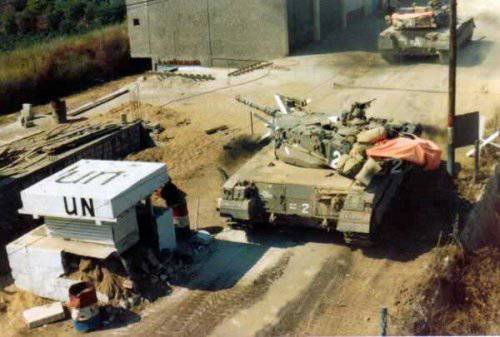
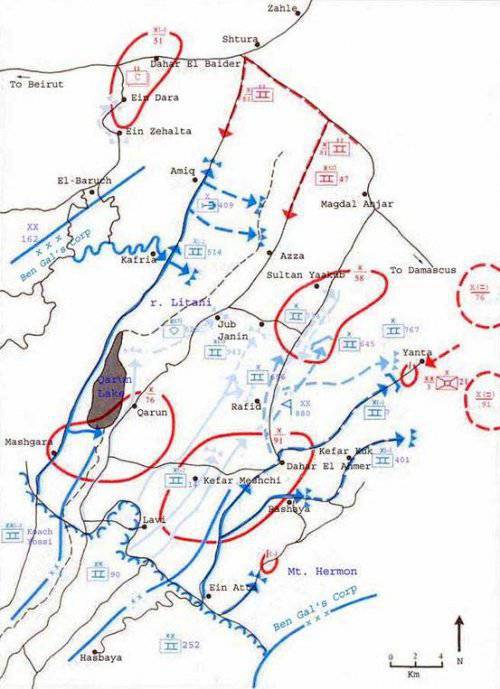
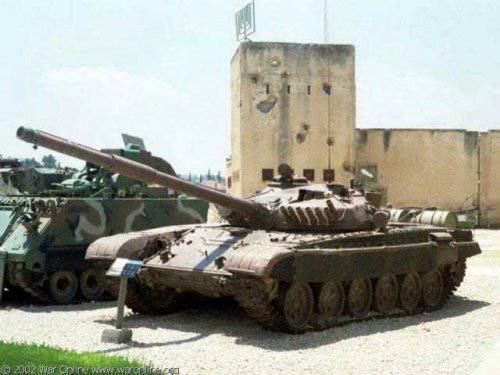
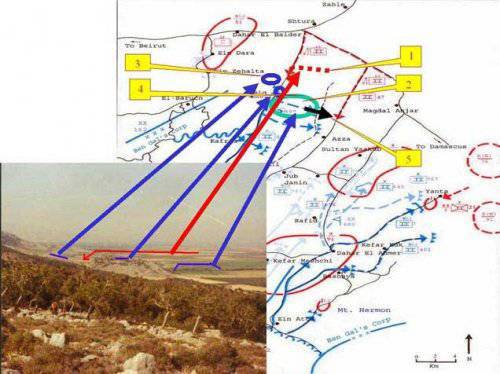
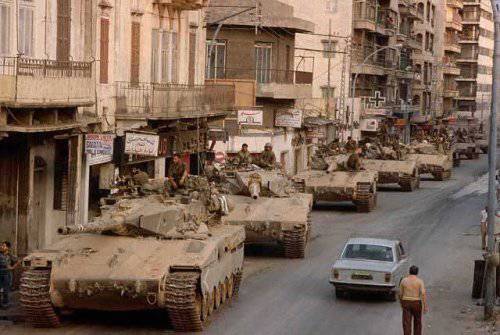
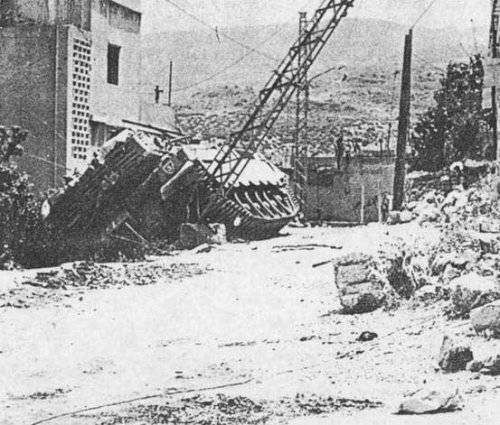
Information